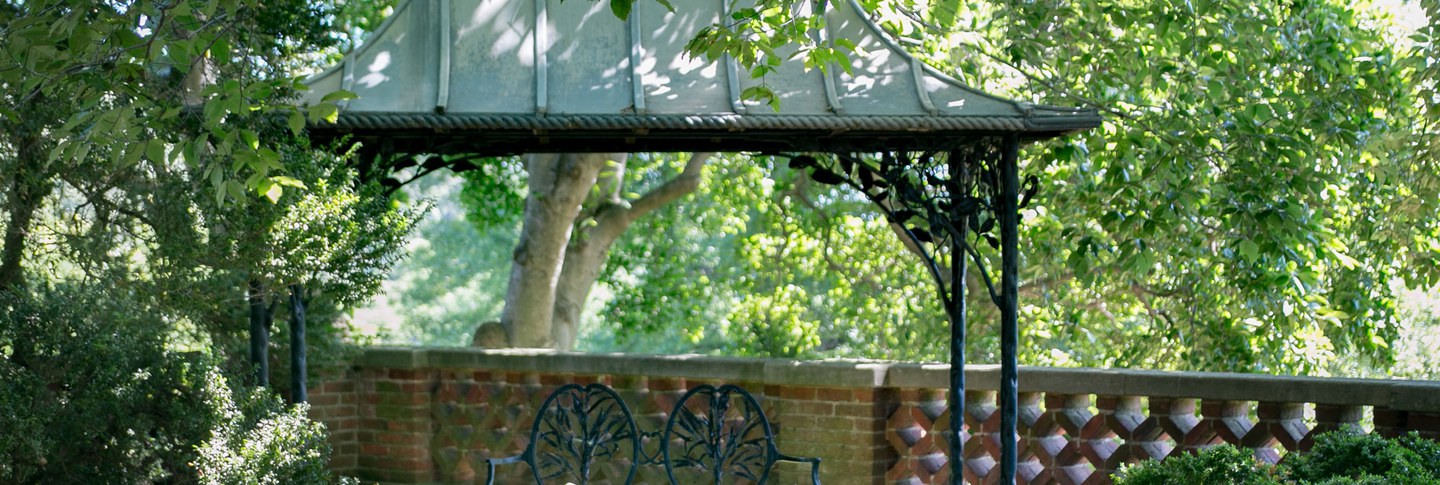By Thaïsa Way
This June we mark a century in the gardens of Dumbarton Oaks as envisioned by Beatrix Farrand in a letter to Mildred Bliss dated June 24–25, 1922. Farrand begins this letter noting that “The Oaks offers opportunities for development on so many different lines that it is difficult to know which to emphasize most strongly in the beginning.” And yet, she did just that—describing a design that was realized over the next twenty-seven years, often figured out on the ground. She describes this design ethos when writing of the north slopes that would “properly be studied from the ground itself rather than from any plan, as the contours and expressions of the ground will control the plantations more strongly than any other feature.” She also noted the essential role that her friendship with Mildred Bliss played, writing in July 1922 that what she would “try to do with the Oaks is to simply be your gardening pair of hands, carrying out your ideas.” Farrand understood the richness of partnering with a generous and creative patron who could both articulate their vision and actively collaborate on the ongoing design of the project. Today, we can experience the vision of Farrand and Bliss even as our visitors, climate, and the role of this research institution continue to change.
To honor a century in the gardens, we also take the opportunity to acknowledge the longer history of the landscape, once the home of Indigenous communities, that remains unceded land. In the early eighteenth century, settlers began to cultivate the land in new ways, using enslaved labor until 1862 with emancipation in the District of Columbia. The landscape was also significantly developed after the Civil War, first by the Linthicums, who likely planted the ficus vine in the Orangery and several the specimen trees, including the katsura. In the early twentieth century, Lucia Eames Blount also added her mark with the planting of boxwoods, added formality in the North Vista, as well as several new flower beds. In 1920 Mildred and Robert Bliss purchased the country house in the city from Blount and almost immediately began to rethink both the house and the landscape. Beatrix Farrand was commissioned in 1921, in collaboration with the architect working on the Main House.
In celebrating the garden and its design, we are hosting a new exhibition on the garden’s history in the museum, as well as a Catalogue House exhibit on stewarding the garden, a virtual tour of the garden’s history on the website, a blog series, and the Art + The Garden podcast. Additionally, we are excited to release a new edition of Beatrix Farrand’s Plant Book and a new book of essays and photographs of the garden, Garden as Art: Beatrix Farrand at Dumbarton Oaks.
Many people have helped to realize the centennial celebrations. Gabe Ziaukas served as the curatorial fellow curating all parts, leading the podcast, and designing the exhibits alongside Ellen Richardson, manager of exhibitions. Jonathan Kavalier, director of gardens and grounds, along with his gardening staff helped in a hundred ways on top of their outstanding care of the gardens. Anatole Tchikine, curator of rare books, contributed to the exhibit by selecting important books that Farrand recommended to Bliss for her expanding collection. Sahar Coston-Hardy, who spent over a year photographing the garden and landscape in all seasons and all weather, contributed significantly to the centennial. Her photographs form a core of the new book Garden as Art and are featured in the on-site exhibit.
Today we enjoy Farrand’s garden art at Dumbarton Oaks. It is one that has matured and transformed over a century, and yet it retains the original creative intentions and visions of Bliss and Farrand. The garden is stewarded by a remarkable staff of dedicated gardeners and horticulturalists as well as the efforts of a team of curators and historians. While the elegance and beauty of the gardens is oft noted, what is less recognized is the important contribution of the garden to the humanities. As Mildred Bliss wrote, “Mediterranean interpretation of the Humanist disciplines shall predominate; that gardens have their place in the Humanist order of life.” Bliss knew the benefit of the humanistic values embodied by the gardens, and it was not only the gardens as a place but that the “trees are noble elements to be protected by successive generations and are not to be neglected or lightly destroyed. . . . The distinction of the scholars themselves as well as of their writings; . . . the free discussion within the limits of good deportment, and the whole tempered by the serenity of open spaces and ancient trees; all these are as integral a part of Humanism at Dumbarton Oaks as are the Library and the Collections.” Each of these statements underscore the garden as a work of art, distinct from a public park or the mere background of a scholarly campus. The landscape remains a work of art, requiring the careful and informed stewardship of the many hands who are responsible for our ability to relish in its beauty.
Thaïsa Way is the director of Garden and Landscape Studies.

